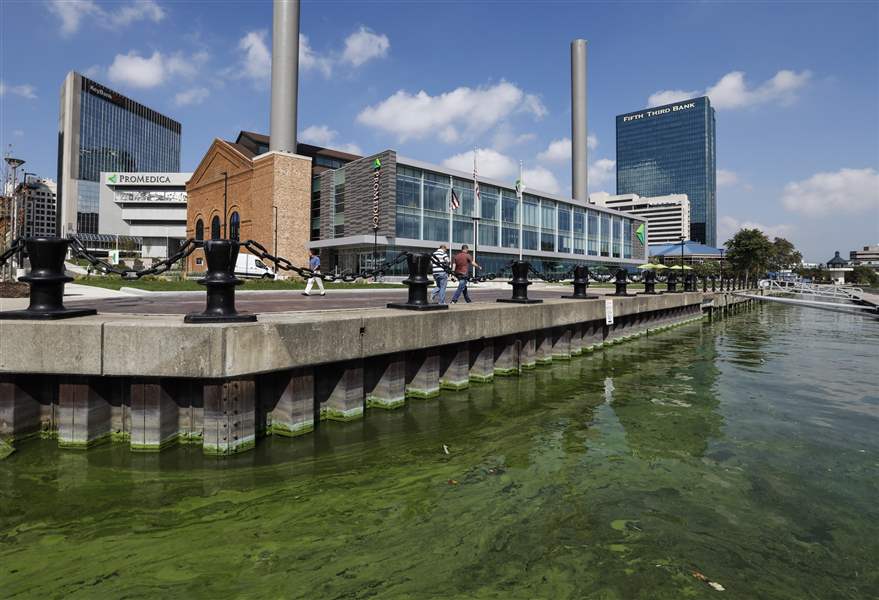
Groups urge faster action to reduce algae in Lake Erie
10/10/2017
Algae in front of the new ProMedica Headquarters in downtown Toledo, Wednesday, September 20.
THE BLADE/ANDY MORRISON
Buy This Image
Several environmental groups are urging Ohio, Michigan, and Ontario to move faster on a commitment they made in 2015 to reduce algae-forming phosphorus entering western Lake Erie by 40 percent within a decade.
The groups claim this summer’s algal bloom in the lake and in the Maumee River near downtown Toledo are proof that progress isn’t being made fast enough. Though the plan for reducing phosphorus input by 40 percent isn’t scheduled to be fully implemented until 2025, the organizations said they expected to see more results by now.
The concerns were outlined in a report called Rescuing Lake Erie: An Assessment of Progress, which was released to the media Tuesday via a webinar arranged by the Chicago-based Alliance for the Great Lakes.
RELATED: State department finishes dead fish investigation
“Unfortunately, the jurisdictions haven't made a lot of progress in solving Lake Erie's problems. Progress has been painfully slow,” Molly Flanagan, Alliance for the Great Lakes vice president of policy, said. “People deserve an update.”
The report’s timing is meant to stir up public support for faster action as Great Lakes governors and premiers prepare to meet in Detroit from Oct. 20 to Oct. 22 to discuss a number of regional issues. The groups said they have delivered petitions signed by more than 13,000 to the Ohio and Michigan governors and Ontario’s premier, calling for swifter action.
Kristy Meyer, Ohio Environmental Council vice president of policy, said Ohio has had a “mixed bag” of cooperation from farmers and others blamed for the majority of nutrients entering rivers and streams that flow into the lake, but added that “clearly enough’s not being done.”
The recent high-profile bloom in the Maumee River near downtown Toledo has raised more questions and a greater sense of urgency, she said.
“There are some legislators who are really paying attention,” Ms. Meyer said. “We need more saying, ‘Enough's enough.’ Every year there is a bloom. What is it going to take to make change in a meaningful way?”
She and others once again called upon the administration of Ohio Gov. John Kasich to declare the open water of western Lake Erie as impaired so it could receive U.S. Environmental Protection Agency support in creating a better inventory of known polluters and use the federal Clean Water Act to establish limits under a government TMDL program, which stands for total maximum daily load.
Ohio EPA Director Craig Butler recently told The Blade and stated in an op-ed for the newspaper that the Kasich administration — while agreeing the pace needs to be accelerated — still believes it is on the right path with voluntary incentives that have been offered to the agricultural community. He also said he fears an impairment designation and TMDL program will break apart relationships and result in more litigation than actual cleanup.
His comments came in response to Toledo Mayor Paula Hicks-Hudson doing an about-face and agreeing to support pleas for an impairment designation, as her challenger, Lucas County Treasurer Wade Kapszukiewicz, has done. Ms. Hicks-Hudson said she dropped her long resistance to the idea after learning about 66,000 fish kills in the Maumee River watershed in August by apparent rogue operators illegally spreading manure as rain approached. She said the river’s bloom was the clincher for her.
Heidi Griesmer, Ohio EPA spokesman, responded to the demands for quicker action Tuesday afternoon with a pledge for a “more robust water monitoring network.”
“We are establishing a more robust water monitoring network throughout the western basin, which includes 28 monitors. Without data, it would be premature to come to any conclusion on progress toward the goal of reducing phosphorus by 40 percent,” she said.
Charlotte Jameson, Michigan League of Conservation Voters government affairs director, said that although Michigan Gov. Rick Snyder has already declared their state’s small portion of Lake Erie as impaired, there are many parts of Michigan that lack water quality monitoring.
“We need to make sure it is consistent,” she said.
The National Oceanic and Atmospheric Administration said in its latest bulletin, issued Tuesday, that algae scum is still visible via satellite in Maumee Bay, but that more does not appear to be forming because water temperatures are starting to decline.
Contact Tom Henry at thenry@theblade.com, 419-724-6079, or via Twitter @ecowriterohio.